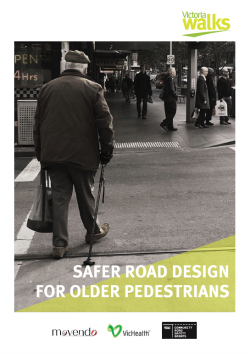Making streets safer for walkers
8 Sep 2016
Victoria Walks has released new research on Safer Road Design for Older Pedestrians with a range of recommendations for safer streets.
People aged 65 and over represent 14.6% of the population but account for 39% of pedestrian fatalities.
The research analysed more than a thousand crashes in Victoria between 2008 and 2013 affecting pedestrians aged 65 years or older. It found that older pedestrians experience an average of 17 fatalities, 147 serious injuries and 114 other injuries in Victoria each year, with an estimated economic cost of $110 million per annum (in 2012 dollar values).
The most common crash scenario for older pedestrians is being hit by a motorist turning right as they exit an intersection – 18% of all crashes. In that scenario, and many other common crashes, the driver was legally required to give way.
In fact, the report suggests that at unsignalised intersections, motorists should have given way in at least 42% of crashes involving older pedestrians. At signalised intersections, motorists were required to give way in at least 72% of crashes.
“Older pedestrians are not risk takers” says Ben Rossiter, Executive Officer of Victoria Walks. “It would appear that they are hit by drivers who don’t know road rules or ignore them, don’t see seniors or simply expect them to get out of the way.”
Vehicles colliding with pedestrians on footpaths, footpath driveways or at entrances to car parks, comprise at least 16% of all older pedestrian crashes, and 23% for those 85 and older.
“It is lamentable that so many of our most vulnerable pedestrians are hit on footpaths, precisely where they should be the most safe”, said Dr Rossiter. “As a community we should be ashamed.”
Victoria Walks is calling for more policing of give way laws, driver focused pedestrian road safety campaigns and better road design that protects seniors when they are walking.
Slater and Gordon Victorian Motor Vehicle Accident Practice Group Leader Joanne Panagakis commented:
“We have assisted hundreds of injured elderly pedestrians with their legal claims over many years and have also represented the families of older pedestrians who have tragically died on our roads. As such, we have seen first-hand the devastating effect that road accidents have on our older clients and their families, both physically and psychologically.”
The report provides detailed recommendations for road design to improve safety for older pedestrians, including:
- Raised pedestrian crossings at intersections and roundabouts to reduce vehicle speeds at the crossing point, enhance priority for pedestrians and make them more conspicuous to drivers.
- Raised thresholds, which effectively extend the footpath across an intersection, to emphasise that drivers are required to give way when turning.
- Kerb extensions, median refuges and tighter turn radii at intersections and roundabouts to reduce vehicle speeds, distance of pedestrian exposure and complexity of crossings.
- Fully controlled right turn signal phases.
- Reduced speed limits and area wide traffic calming.
- Safer design standards for driveways to indicate priority for pedestrians and provide physical cues for drivers.
“Instead of telling older people to ‘take care’ when they are walking, we need to design streets that take care of them”, Dr Rossiter said.
“The number of people aged 65 and over is expected to almost triple in the next 40 years”, Dr Rossiter said. “It is imperative we do something now, or it will mean more death and injuries in the future.”
Of course, if we make streets safer for older pedestrians, they will be safer for everyone.
The report was prepared by transport consultants movendo (lead author Jose Mantilla) and Victoria Walks (Duane Burtt), in collaboration with the Municipal Association of Victoria (MAV). Funding was provided by a Community Road Safety Grant from the Transport Accident Commission (TAC), along with VicHealth’s ongoing support of Victoria Walks.